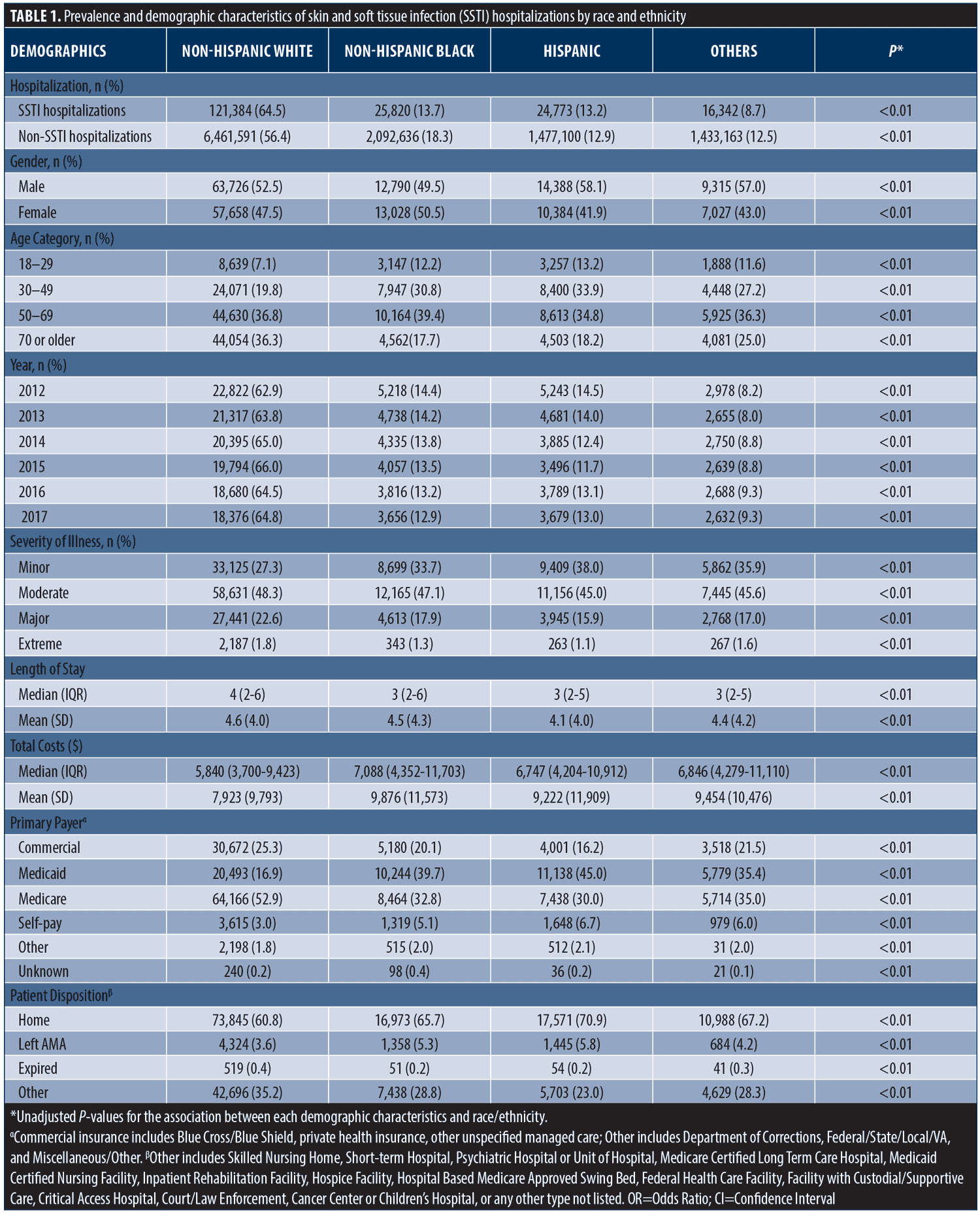 J Clin Aesthet Dermatol. 2023;16(11):19–21.
J Clin Aesthet Dermatol. 2023;16(11):19–21.
by Tannaz Sedghi, MD, MPH; Jeffrey M. Cohen, MD; and Hao Feng, MD, MHS
Drs. Sedghi and Feng are with the Department of Dermatology at the University of Connecticut Health Center in Farmington, Connecticut. Dr. Cohen is with the Department of Dermatology at Yale University School of Medicine in New Haven, Connecticut.
FUNDING: No funding was provided for this article.
DISCLOSURES: Dr. Feng is a consultant for Cytrellis Biosystems Inc. and Soliton Inc.
ABSTRACT: Skin and soft tissue infections (SSTI) can result in hospitalizations and lead to increased healthcare costs and morbidity. Racial and ethnic disparities in healthcare access, utilization, and outcomes are well-documented. However, limited studies exist on racial and ethnic differences among adult patients hospitalized for SSTI. Our study utilized a large dataset from New York State to investigate such differences. Findings suggest that racial and ethnic minority patients hospitalized for SSTI are younger, primarily covered by Medicaid, and have a higher cost of hospitalization compared to White patients, even after controlling for length of stay and severity of illness. Possible explanations for these disparities include differences in comorbidities and structural vulnerabilities. Further studies are needed to elucidate potential causes of these disparities and their impact on clinical outcomes. Keywords: General dermatology, medical dermatology, infectious disease, clinical research, skin and soft tissue infections
Skin and soft tissue infection (SSTI) is common and accounts for an increasing number of hospitalizations.1 Epidemiologic data on racial/ethnic differences among adult patients hospitalized for SSTI are limited, but we hypothesize such differences exist.
Methods
We utilized the publicly available 2012–2017 Hospital Inpatient Discharges datasets from the Statewide Planning and Research Cooperative System (SPARCS) database, which contains demographic and select clinical information for 100 percent of inpatient admissions to all non-federal hospitals in New York State. Hospitalizations for SSTI were defined as those with All Patient Refined Diagnosis-Related Groups code of “Cellulitis or other skin infections.” We categorized race/ethnicity as: Hispanic, Non-Hispanic White (“White”), Non-Hispanic Black (“Black”), and Other Race (“Others”). We excluded those under the age of 18 or with unknown or multiple race/ethnicities. Chi-squared, Wilcoxon-Mann Whitney, and t-tests were utilized to compare prevalence and demographic characteristics by race/ethnicity, and multinomial logistic regression models were utilized to control for potential confounding by severity of illness (SOI), length of stay (LOS), and age group, where appropriate. SOI was defined in the database as minor, moderate, major, or extreme based on the extent of organ system loss of function or physiologic decompensation.
Results
There were 188,319 hospitalizations for SSTI from 2012 to 2017 (Table 1). Hispanic and Black patients composed 38 percent of patients ages 18 to 29 compared to 16 percent of patients 70 years or older. Overall, White patients were hospitalized for more severe disease (“major” or “extreme”) (24.4%) compared to Black (19.2%) and Hispanic (17%) patients; however, when controlling for age, White patients were hospitalized for more severe disease among those ages 50 and older (30.2% among White patients vs. 25.7%) and Black patients among those younger than 50 (10.6% among Black patients vs. 8.8%). The adjusted cost of hospitalization for SSTI was higher among Black ($9,934) and Hispanic ($9,919) patients compared to White patients ($7,650). Compared to other groups, White patients were overall less likely to have Medicaid as a primary insurance. These associations remained in multinomial analyses (Table 2).
Discussion
Racial and ethnic minority patients hospitalized for SSTI are younger, primarily covered by Medicaid, and have a higher cost of hospitalization compared to White patients, regardless of SOI or LOS. These results are consistent with studies showing that racial and ethnic minority patients have higher rates of SSTI in younger age groups4 and higher odds of increased resource utilization during hospitalizations,5 and are important to consider in the context of racial differences in antibiotic management for SSTI.6 Possible explanations for these findings include differences in prevalence of comorbidities (e.g., diabetes) and other structural vulnerabilities faced by racial and ethnic minority patients. The reasons for the observed racial/ethnic differences among SSTI patients of different age groups are unclear.
The generalizability of these results is limited by the data source and coding as SPARCS data only includes hospitalizations from New York, provides limited patient-level information, and excludes outpatient visits. Moreover, SOI is categorized broadly and specific differences in disease severity or course of illness are not available in the database. Nonetheless, this study utilizes a large and comprehensive population to highlight existing racial/ethnic differences among adult patients hospitalized for SSTI and provides a groundwork to elucidate possible causes and their potential clinical ramifications.
References
- Peterson RA, Polgreen LA, Cavanaugh JE, et al. Increasing incidence, cost, and seasonality in patients hospitalized for cellulitis. Paper presented at: Open forum infectious diseases 2017.
- Van der Geer J, Hanraads JAJ, Lupton RA. The art of writing a scientific article. J Sci Commun. 2010;163:51–59.
- Buster KJ, Stevens EI, Elmets CA. Dermatologic health disparities. Dermatologic clinics. 2012 Jan 1;30(1):53–59.
- Ray GT, Suaya JA, Baxter R. Incidence, microbiology, and patient characteristics of skin and soft-tissue infections in a US population: a retrospective population-based study. BMC infectious diseases. 2013 Dec;13(1):1–1.
- Lopez MA, Cruz AT, Kowalkowski MA, et al. Factors associated with high resource utilization in pediatric skin and soft tissue infection hospitalizations. Hospital pediatrics. 2013 Oct 1;3(4):348–354.
- Wurcel AG, Essien UR, Ortiz C, et al. Variation by Race in Antibiotics Prescribed for Hospitalized Patients With Skin and Soft Tissue Infections. JAMA Netw Open. 2021;4(12):e2140798. doi:10.1001/jamanetworkopen.2021.40798



